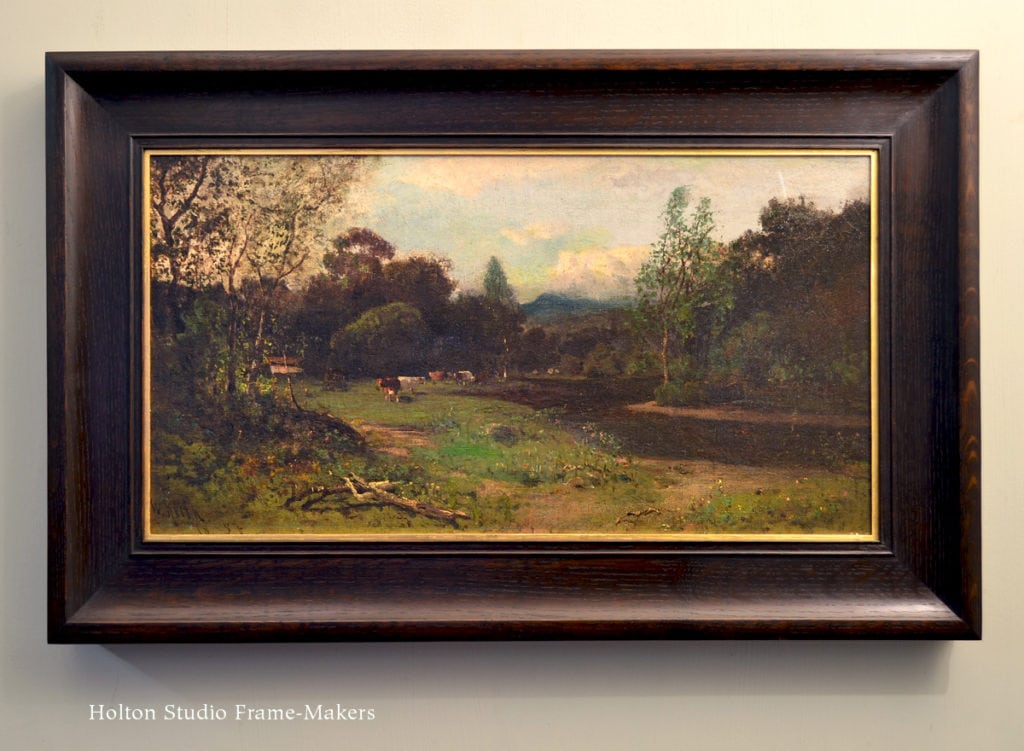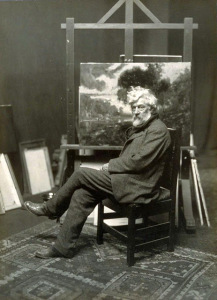Another painting we framed and which is now on display at the North Point Gallery (along with the pieces that were subject of my last two posts) as part of its show “Historical Artists of the East Bay” is by William Keith (1838-1911), an artist considered not only one of the East Bay’s great early painters but one of California’s. “Mt. Tamalpais and Lagunitas Creek,” 1878 (oil on canvas, 12″ x 23″), depicts a favorite spot of Keith’s in Marin County. We set it in a 3-1/4″ wide cove molding, No. 348.108.1, to not only enhance but sustain the idyllic, pastoral scene in to the room in which the picture hangs. A couple of fine beads on the profile acknowledge the delicate brushwork used to render the still evening along the tree-lined creek. The wood is quartersawn white oak with Saturated Medieval Oak stain that matches the deep shadows. The frame has a 23 kt gilt slip.
Not long ago, a customer visiting from the mid-west came through the gallery telling me how all the paintings in his Illinois home are of California. When I asked why that was, he replied, “Because this is where the beauty is.” It’s not a rare sentiment; William Keith expressed it long ago. Born in Scotland, Keith returned to Europe to study painting—on one trip he accompanied his great friend and fellow-Scot John Muir who was headed to the Swiss Alps to study the glaciers—but always happily came back to his adopted home of California, firm in his belief that the state’s exceptionally beautiful natural landscape destined it to someday become the site for another Renaissance, with painting being restored here to its authentic bases.
In 1893 Keith told the San Francisco Call,
“This is the place for art. We have everything that will make it a great art center. We have the climate; we have the scenery, and has it not always been in this sort of climate and scenery that art has flourished most? Our scenery is grander and our climate more congenial even than those others similar where art has thrived in the Old World… In the East and in Europe they have more pictures to study, while here we are thrown upon our own resources and must copy from nature and form our own individualities. An artist, however, who sees too many pictures is apt to lose his personality and become a copyist.
A couple of years later, in an article called “The Future of Art in California,” written by Keith for the same paper, the painter said,
Eastern people who visit the San Francisco studios are surprised at what they see. They have always known of California’s gold, and of later years of her oranges—but California painters! …California artists are as gifted as those of New York, and those of New York as those of Paris… This State is destined to be the Italy of America—all, I believe, that Italy ever was to the world of art…. Some day San Francisco will become a great art center, and students from far off will journey to this City as they now journey to Rome…”
Yet, in the same breath, he expressed deep concern that “California has lost the faculty of seeing the wealth at her own door, even as the East long ago began to look still further east for its wants in art and literature. This is painfully apparent to artists…” Such decline, though, only increased the sense on the part of Keith and his fellow painters of the importance of their mission here: inspired by and rooted in the great beauty of the state’s natural landscape, painting and the arts must surely grow and flourish at least as much as they had anywhere before.
Rich evidence of this spirit is on display through June 30 in North Point Gallery’s show, “Historic Artists of the East Bay.” The rare chance to partake of such inspiration should not be missed!
« Back to Blog
